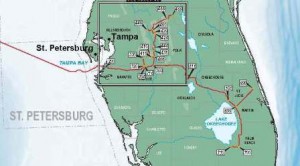KECE began working on the Gulfstream Natural Gas System’s pipeline project in the spring of 1999, providing support, training, and quality assurance for over 300 miles of habitat mapping, wetland jurisdictional delineations, and listed species surveys along the pipeline corridor, and assisting the Gulfstream team in obtaining federal and state permits. One of KECE’s primary functions was to identify, assess and design habitat restoration and enhancement plans for wetland mitigation and net ecosystem benefits (NEB) sites. KECE also assisted in the contractor selection and provided oversight during the restoration activities on the mitigation sites. KECE ecologists are responsible for monitoring the restoration sites until the habitats are successfully established.
The listed species surveys were conducted along the pipeline corridor for approximately 64 listed plant and animal species. Conservation measures, management plans, and implementation plans were prepared for federal and state listed species including the American bald eagle, southeastern American kestrel, Florida scrub jay, Florida grasshopper sparrow, listed wading birds, sand skink, bluetail mole skink, eastern indigo snake, gopher tortoise, and Sherman’s fox squirrel. The majority of the behavior monitoring during construction was conducted by KECE ecologists for listed species with protection zones such as American bald eagles, wading bird roosts and rookeries, and southeastern American kestrels.During the environmental permitting process, KECE assessed dozens of properties across central Florida to identify available private lands that had the potential to provide on-site and regional restoration value for mitigation and to provide net environmental benefits to offset the unavoidable disturbance to native ecosystems (198 acres of forested wetlands and 473 acres of non-forested wetlands) due to the pipeline construction. Pursuant to this evaluation, Gulfstream and the permitting agencies identified two Gulfstream Mitigation / NEB sites: Manatee (200 acres) and Lake Wales Forest (400 acres). KECE also finalized design plans and provided construction supervision of the Port Manatee Spoil Island (60 acres) restoration project that was conducted by Gulfstream as part of an access agreement. Additionally, KECE provided oversight for the Harbor Key coastal strand restoration that focused on the removal of dense exotic vegetation from ecologically sensitive areas.
These four habitat restoration/enhancement projects total more than 676 acres in Polk and Manatee Counties. The Manatee and Lake Wales Forest restoration sites are inland and include approximately 596 acres of exotic vegetation removal and control, 185 acres of forested wetlands restoration, the creation of approximately 34 acres of marsh, and more than 200 acres of upland habitat enhancement. These two inland sites are expected to reach the permit success criteria by 2010. The Port Manatee spoil island and Harbor Key restoration sites are coastal ecosystems including approximately 30 acres of exotic vegetation control, 16.4 acres of mangrove/tidal creek creation, and approximately 42 acres of upland enhancement. Both coastal restoration sites have reached permit success criteria.
Additional information on Gulfstream Natural Gas System, LLC
